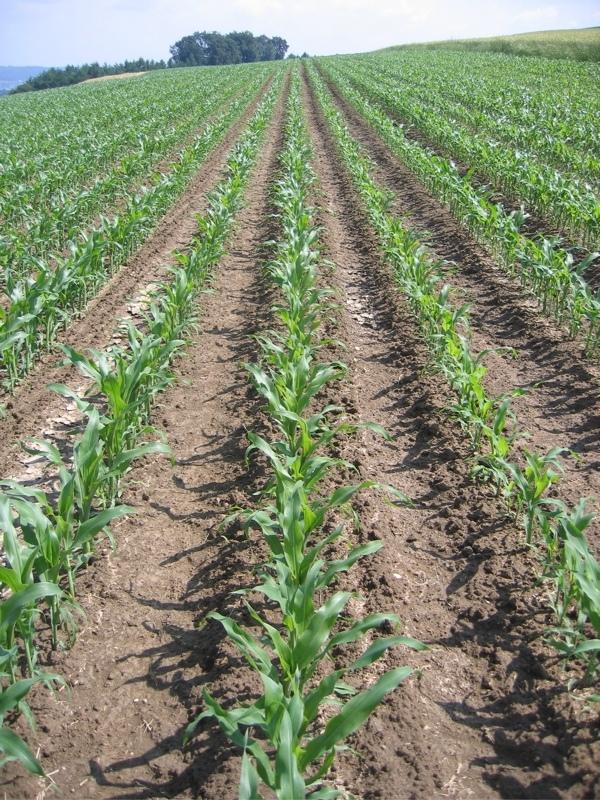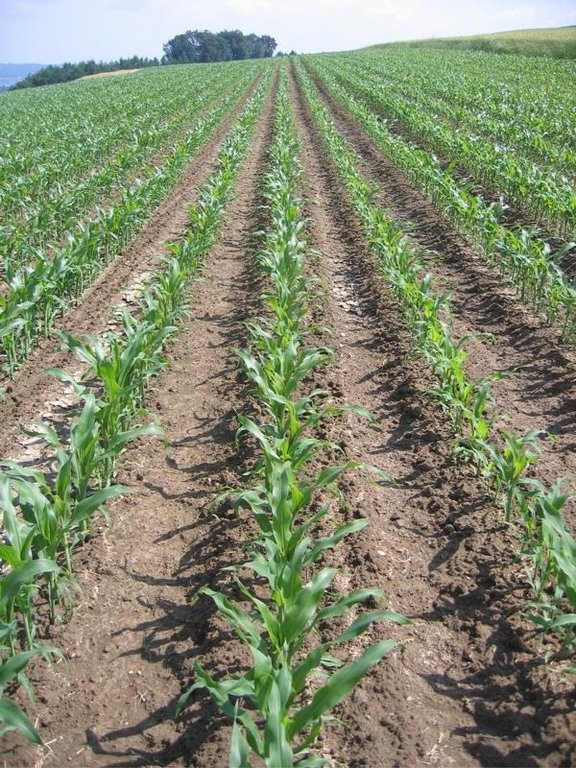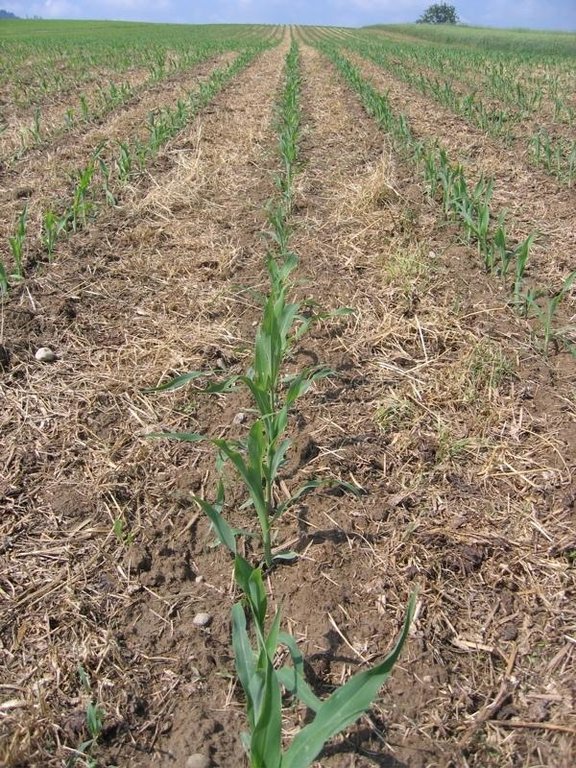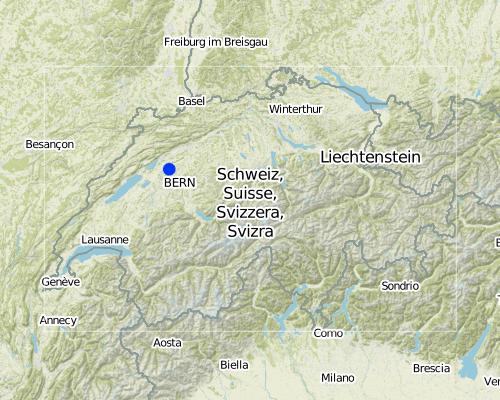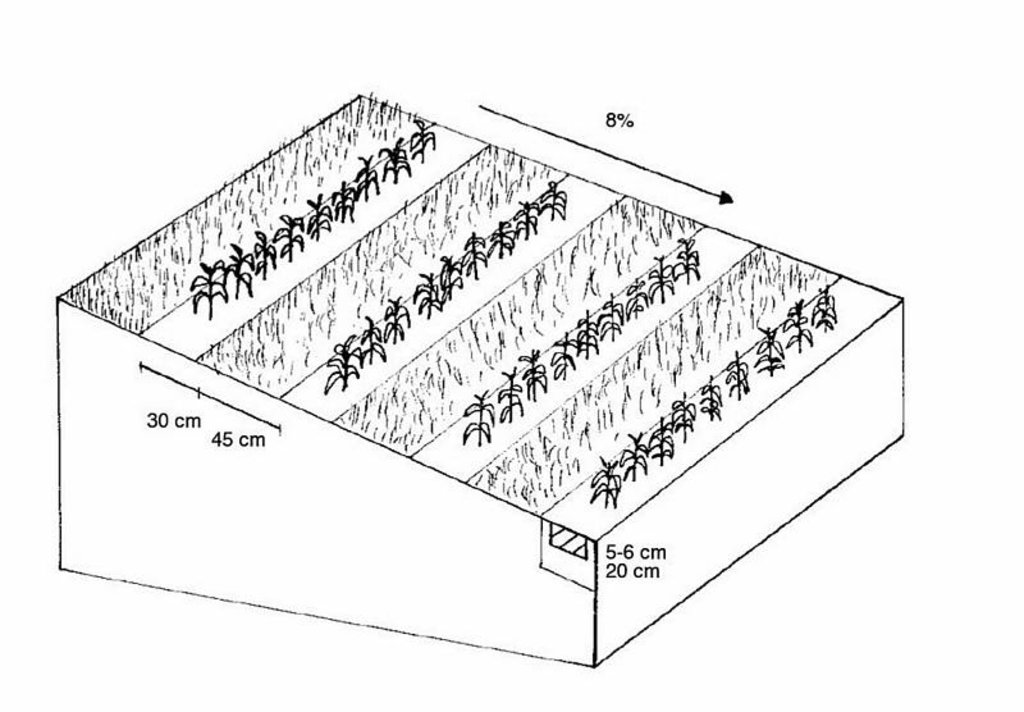Maize strip tillage [Switzerland]
- Creation:
- Update:
- Compiler: Unknown User
- Editor: –
- Reviewer: Fabian Ottiger
Streifenfrässaat
technologies_1008 - Switzerland
View sections
Expand all Collapse all1. General information
1.2 Contact details of resource persons and institutions involved in the assessment and documentation of the Technology
Key resource person(s)
SLM specialist:
Buddeke Giulietta
Geographisches Institut der Universität Bern -GIUB
Muristrasse 94, 3006 Bern, Switzerland
Switzerland
land user:
Friederich Jürg
+41 (0) 79 351 30 66,
j.friederich@mysunrise.ch
Landwirtschaftliches Lohnunternehmen Seelandzenturm Suberg
Martinsmatt 50, 3262 Suberg, Switzerland
Switzerland
Name of the institution(s) which facilitated the documentation/ evaluation of the Technology (if relevant)
Jürg Friederich Lohnunternehmung - SwitzerlandName of the institution(s) which facilitated the documentation/ evaluation of the Technology (if relevant)
University of Bern, Institute of Geography (GIUB) - Switzerland1.3 Conditions regarding the use of data documented through WOCAT
When were the data compiled (in the field)?
30/10/2008
The compiler and key resource person(s) accept the conditions regarding the use of data documented through WOCAT:
Ja
2. Description of the SLM Technology
2.1 Short description of the Technology
Definition of the Technology:
Maize strip tillage is used for corn cultivation and the technology ensures that only those stripes are cultivated where seed is applied.
2.2 Detailed description of the Technology
Description:
Maize strip tillageis a soil conservation method used in crop production. First of all the grass in the area needs to be prepared by splattering round-up some 3-10 days in advance. Then the actual maize strip tillage machine carves a stripe and the seed are inserted within this 30 cm strip. At the same time fertilizer is added on these cultivated stripes. Between those cultivated stripes the mulch-grass stripes (45cm) are unmechanised and protect the soil by increasing its stability. Due to these mulch-stripes the matrix of the soil is more complex and therefore the stability is better especially during the harvest in September. The interviewed farmer said it was cause of the improved soil structure that his tractors are not subside and compaction is also less likely to occur. Another advantage is the decreased risk of soil erosion when having more and heavy precipitation, as it is expected for next decades due to climate changes in Switzerland. Thanks to the SLM technology, water infiltration increases and organic matter as well which adds up to a promising growth period.
There are also clear economic advantages, by adopting the technology. In springtime only one working step is needed for seeding compared to the five steps needed with the traditional technique using a plough. Therefore the costs are finally lower with this technology and farmers can use the opportunity when having free labour to work part-time outside the farm. At first sight, the costs might seem higher when adopting this technology cause the farmer needs to hire a subtractor, in the end the costs are lower due to the lower labour input and the lower equipment costs. After having seen the advantages, the interviewed farmer said that the technology is usually maintained.
A high level of knowledge about the natural condition is needed when adopting this technology. On the one hand, the farmer must time the date for seeding adequately to the natural conditions, it needs some 4 days with no precipitation. Then on the other hand, the farmer has to apply Glyphosphat after the seeding in order to guarantee an optimal growth period for the corn. The timing to start seeding with this technology may be later cause corn is sensitive towards rival plants, low temperatures and humidity. These are some of the limits that the technology implies. If springtime is humid, the farmer should be allowed to use the traditional technique, regardless of the subsidies as indicated by the interviewed farmer. The canton of Bern is providing subsidies if the farmer commits to use a five year cycle which inherits not to use the plough during this period but using a mulch system. The interviewed farmer suggests that the canton of Bern could commit itself not only in giving subsidies to the areas but also to support if contractors like him would get subsidies for the investment for machines that are needed. For a single farmer the establishment costs for the equipment are too high so that the average is hiring a contractor who could work for a lower salary when having support to buy machines, so subsidies from the Cantons would be an asset.
2.3 Photos of the Technology
2.5 Country/ region/ locations where the Technology has been applied and which are covered by this assessment
Country:
Switzerland
Region/ State/ Province:
Bern
Further specification of location:
Suberg
Map
×2.6 Date of implementation
If precise year is not known, indicate approximate date:
- less than 10 years ago (recently)
2.7 Introduction of the Technology
Specify how the Technology was introduced:
- during experiments/ research
Comments (type of project, etc.):
Peter Hofer made different experiments wiht SLM Technologies and after successful implementation of maize strip tillage, idea was adopted
3. Classification of the SLM Technology
3.2 Current land use type(s) where the Technology is applied

Cropland
- Annual cropping
Comments:
Major land use problems (compiler’s opinion): Soil erosion in hilly areas
Major land use problems (land users’ perception): Due to changed weather conditions, basically an increase of percipitation, soil erosion increased
Future (final) land use (after implementation of SLM Technology): Cropland: Ca: Annual cropping
If land use has changed due to the implementation of the Technology, indicate land use before implementation of the Technology:
Cropland: Ca: Annual cropping
3.3 Further information about land use
Number of growing seasons per year:
- 1
Specify:
Longest growing period in days: 150Longest growing period from month to month: Apr - Sep
3.4 SLM group to which the Technology belongs
- minimal soil disturbance
- cross-slope measure
3.5 Spread of the Technology
Specify the spread of the Technology:
- evenly spread over an area
If the Technology is evenly spread over an area, indicate approximate area covered:
- 0.1-1 km2
Comments:
3 farms joint together
3.6 SLM measures comprising the Technology

agronomic measures
- A1: Vegetation/ soil cover
Comments:
Main measures: agronomic measures
Type of agronomic measures: cover cropping, retaining more vegetation cover, mulching, manure / compost / residues, rotations / fallows, minimum tillage
3.7 Main types of land degradation addressed by the Technology

soil erosion by water
- Wt: loss of topsoil/ surface erosion
- Wg: gully erosion/ gullying

physical soil deterioration
- Pc: compaction

biological degradation
- Bc: reduction of vegetation cover
Comments:
Main type of degradation addressed: Wt: loss of topsoil / surface erosion
Secondary types of degradation addressed: Wg: gully erosion / gullying, Pc: compaction, Bc: reduction of vegetation cover
Main causes of degradation: crop management (annual, perennial, tree/shrub) (using a plough in hilly area increases soil erosion)
3.8 Prevention, reduction, or restoration of land degradation
Specify the goal of the Technology with regard to land degradation:
- prevent land degradation
- reduce land degradation
Comments:
Main goals: mitigation / reduction of land degradation
Secondary goals: prevention of land degradation
4. Technical specifications, implementation activities, inputs, and costs
4.1 Technical drawing of the Technology
4.2 Technical specifications/ explanations of technical drawing
Technical knowledge required for field staff / advisors: high
Technical knowledge required for land users: moderate
Main technical functions: improvement of ground cover
Secondary technical functions: improvement of topsoil structure (compaction), increase in organic matter, increase of infiltration
4.3 General information regarding the calculation of inputs and costs
other/ national currency (specify):
Swiss Franc
Indicate exchange rate from USD to local currency (if relevant): 1 USD =:
1.08
Indicate average wage cost of hired labour per day:
194.00
4.4 Establishment activities
| Activity | Type of measure | Timing | |
|---|---|---|---|
| 1. | Buy a machine for technology | Agronomic |
Comments:
Number of parties sharing: 2
4.5 Costs and inputs needed for establishment
| Specify input | Unit | Quantity | Costs per Unit | Total costs per input | % of costs borne by land users | |
|---|---|---|---|---|---|---|
| Labour | applying round-up | ha | 1.0 | 97.0 | 97.0 | 100.0 |
| Labour | maize strip tillage | ha | 1.0 | 388.0 | 388.0 | 100.0 |
| Equipment | Tools | ha | 1.0 | 56300.0 | 56300.0 | 100.0 |
| Total costs for establishment of the Technology | 56785.0 | |||||
Comments:
Duration of establishment phase: 2 month(s)
4.6 Maintenance/ recurrent activities
| Activity | Type of measure | Timing/ frequency | |
|---|---|---|---|
| 1. | Applying round up on the field | Agronomic | 1 |
| 2. | Applying maize strip tillage | Agronomic | 1 |
| 3. | Add herbicide on field | Agronomic | 1 |
| 4. | Harvest of the corn | Agronomic | 1 |
4.7 Costs and inputs needed for maintenance/ recurrent activities (per year)
Comments:
Establishment costs are estimated for the contractor on the one hand and labour costs indicated above are the ones that the contractor is demanding for if he is hired. Additionally, those farmers who adapt this technology can get subsidies from the Canton if he/she commits to apply soil conservating measurements during 5 years, in Bern it is 450 CHF per ha.
4.8 Most important factors affecting the costs
Describe the most determinate factors affecting the costs:
Labour costs and costs for diesel are much higher for the traditional technology (plough). The investment for the technology are high in the first term and the labour costs indicated above are given by the contractor if he is hired. So for a regular farmer only these 388 USD are relevant.
5. Natural and human environment
5.1 Climate
Annual rainfall
- < 250 mm
- 251-500 mm
- 501-750 mm
- 751-1,000 mm
- 1,001-1,500 mm
- 1,501-2,000 mm
- 2,001-3,000 mm
- 3,001-4,000 mm
- > 4,000 mm
Specifications/ comments on rainfall:
Tendency towards increased rainfall
Agro-climatic zone
- sub-humid
Thermal climate class: temperate
5.2 Topography
Slopes on average:
- flat (0-2%)
- gentle (3-5%)
- moderate (6-10%)
- rolling (11-15%)
- hilly (16-30%)
- steep (31-60%)
- very steep (>60%)
Landforms:
- plateau/plains
- ridges
- mountain slopes
- hill slopes
- footslopes
- valley floors
Altitudinal zone:
- 0-100 m a.s.l.
- 101-500 m a.s.l.
- 501-1,000 m a.s.l.
- 1,001-1,500 m a.s.l.
- 1,501-2,000 m a.s.l.
- 2,001-2,500 m a.s.l.
- 2,501-3,000 m a.s.l.
- 3,001-4,000 m a.s.l.
- > 4,000 m a.s.l.
Comments and further specifications on topography:
Altitudinal zone: 101-1000 m a.s.l. (depending on the area)
5.3 Soils
Soil depth on average:
- very shallow (0-20 cm)
- shallow (21-50 cm)
- moderately deep (51-80 cm)
- deep (81-120 cm)
- very deep (> 120 cm)
Soil texture (topsoil):
- medium (loamy, silty)
Topsoil organic matter:
- medium (1-3%)
If available, attach full soil description or specify the available information, e.g. soil type, soil PH/ acidity, Cation Exchange Capacity, nitrogen, salinity etc.
Soil fertility is medium
Soil drainage/infiltration is good
Soil water storage capacity is medium
5.4 Water availability and quality
Ground water table:
5-50 m
Water quality (untreated):
good drinking water
Comments and further specifications on water quality and quantity:
Availability of surface water: good, medium ( depending on the area )
Water quality (untreated): Good drinking water ( generally good quality of water )
5.5 Biodiversity
Species diversity:
- medium
Comments and further specifications on biodiversity:
depending on the area
5.6 Characteristics of land users applying the Technology
Off-farm income:
- 10-50% of all income
Relative level of wealth:
- rich
Individuals or groups:
- individual/ household
Indicate other relevant characteristics of the land users:
Difference in the involvement of women and men: Generally speaking, men tend to work on the fields therefore are mainly responsible for technologies, women tend to work in the houshold and are responsible for administrative tasks. In Switzerland there is a traditional labour division between men and women, there might be exceptions but if addressing new technology one has to deal with male farmers. Assuming that decisions to adapt new technologies or for investments are made by both.
Population density: 10-50 persons/km2
Annual population growth: < 0.5%
Off-farm income specification: For those farmers working off-farm it is likely to delegate work to contractor. On the other hand when hiring a contractor there is less labour needed for the farmer and the possibility to work off-farm slightly higher.
5.8 Land ownership, land use rights, and water use rights
Land ownership:
- individual, not titled
Land use rights:
- communal (organized)
Water use rights:
- communal (organized)
Comments:
Half of the land is leased and the other was bought by the farmer. He said there is a tendency towards land selling.
5.9 Access to services and infrastructure
health:
- poor
- moderate
- good
education:
- poor
- moderate
- good
technical assistance:
- poor
- moderate
- good
employment (e.g. off-farm):
- poor
- moderate
- good
markets:
- poor
- moderate
- good
energy:
- poor
- moderate
- good
roads and transport:
- poor
- moderate
- good
drinking water and sanitation:
- poor
- moderate
- good
financial services:
- poor
- moderate
- good
6. Impacts and concluding statements
6.1 On-site impacts the Technology has shown
Socio-economic impacts
Production
risk of production failure
Comments/ specify:
Conditions need to be good, if season too wet, harvest can decrease
Income and costs
expenses on agricultural inputs
workload
Other socio-economic impacts
Use of pesticides
Comments/ specify:
Consequences of using pesticide are not known yet, traces in drinking water might be likely to occure
Socio-cultural impacts
SLM/ land degradation knowledge
conflict mitigation
Ecological impacts
Water cycle/ runoff
surface runoff
Soil
soil loss
soil organic matter/ below ground C
Biodiversity: vegetation, animals
invasive alien species
Comments/ specify:
More crows are on the fields after seeding
pest/ disease control
Other ecological impacts
Infiltration
6.3 Exposure and sensitivity of the Technology to gradual climate change and climate-related extremes/ disasters (as perceived by land users)
Gradual climate change
Gradual climate change
| Season | Type of climatic change/ extreme | How does the Technology cope with it? | |
|---|---|---|---|
| annual temperature | increase | well |
Climate-related extremes (disasters)
Meteorological disasters
| How does the Technology cope with it? | |
|---|---|
| local rainstorm | well |
| local windstorm | not known |
Climatological disasters
| How does the Technology cope with it? | |
|---|---|
| drought | well |
Hydrological disasters
| How does the Technology cope with it? | |
|---|---|
| general (river) flood | not known |
Other climate-related consequences
Other climate-related consequences
| How does the Technology cope with it? | |
|---|---|
| reduced growing period | not well |
Comments:
With the grass stripes between the corn rows, the water can infiltrate faster and the soil is more stable and protected. The technology can be more tolerant towards intensive rainfalls but only to a certain extent. The technology is more sensitive when having humid conditions in spring and problems can occure then when trying to apply the stripe mill cropping..
6.4 Cost-benefit analysis
How do the benefits compare with the establishment costs (from land users’ perspective)?
Short-term returns:
negative
Long-term returns:
positive
How do the benefits compare with the maintenance/ recurrent costs (from land users' perspective)?
Short-term returns:
slightly positive
Long-term returns:
positive
6.5 Adoption of the Technology
Comments:
35% of land user families have adopted the Technology with external material support
Comments on acceptance with external material support: When having good experiences with technology, some 80-90% of the farmers are maintaining this technology
6.7 Strengths/ advantages/ opportunities of the Technology
| Strengths/ advantages/ opportunities in the land user’s view |
|---|
|
less workload How can they be sustained / enhanced? Farmers should estimate their own labour time as well and then compare the costs of traditional technology and the SLM technology |
|
less costs How can they be sustained / enhanced? In the long-term costs for a farmer decrease by a third. Less diesel costs are needed. |
|
less erosion How can they be sustained / enhanced? Subsidies of the cantons could ensure that farmers adapt technology, therefore enhance their knowledge about soil erosion and the costs. |
| Strengths/ advantages/ opportunities in the compiler’s or other key resource person’s view |
|---|
|
reduction of soil erosion How can they be sustained / enhanced? Enhancing knowledge about soil erosion |
|
improvement of soil structure How can they be sustained / enhanced? Enhancing knowledge by experiments shown to farmers |
6.8 Weaknesses/ disadvantages/ risks of the Technology and ways of overcoming them
| Weaknesses/ disadvantages/ risks in the land user’s view | How can they be overcome? |
|---|---|
| Timing is needed | Enhance knowledge about technology when conditions are too wet, farmers should be allowed to use plough instead of SLM technology |
| Subsidies only for areas | Canton could subsidies/support if contractor or farmer invests in a machine used for strip mill cropping. 5 years of subsidies might be too short |
| Weaknesses/ disadvantages/ risks in the compiler’s or other key resource person’s view | How can they be overcome? |
|---|---|
| use of pesticide | It is not estimated yet whether the use of pesticide has traces in the drinking water |
Links and modules
Expand all Collapse allLinks
No links
Modules
No modules


